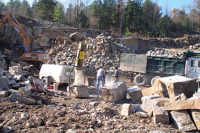
Abundant in natural beauty, the Adirondack Mountains of Upstate New York have long been known as a premier setting for outdoor enthusiasts. However, a recent development there has also made it an interesting destination for the stone industry, as Barton Mines Co., LLC, has opened a quarry for Garnet Gem® granite.
The block quarrying operation is known as Barton Quarries, and it is a division of Barton Mines Co., the roots of which date back to 1876, when founder Henry Hudson Barton opened a sandpaper supply shop in Philadelphia, PA. Searching for a better sandpaper abrasive, he discovered garnet and began mining operations near North Creek, NY, in 1878, and this venture prospered for over a century. In 1983, mining operations were re-located from Gore Mountain to nearby Ruby Mountain, and this is also where the dimensional stone is quarried today.
Quarrying operations
Barton Quarries began producing blocks regularly in July of 2004, and the continued development of the quarry is carefully planned to minimize visual impact. The quarry is located on an 850-acre site that also includes the garnet-producing operation.Garnet Gem granite is highlighted by deep red garnet crystals that typically range 1â„4 to 3â„4 inches in diameter, explained Tim Conboy,
Vice President of Strategic Planning for Barton Mines Co. The garnet crystals are set against a background of black hornblende, pale green/white feldspar and random linear veins of varying colors. Conboy also pointed out that garnet is a popular gemstone, as it is the official New York State gem as well as the official birthstone for the month of January. In addition to its unique aesthetics, Conboy said Garnet Gem granite features high durability, and is resistant to scratching, heat and staining.
Equipment in use at the quarry includes a Tamrock Commando 120 drill from Finland, which is remote controlled and is used for initial quarry development work. In December of last year, Barton Quarries added a Novamac Apache line drill from Canada, which drills both vertically and horizontally and has a moving head that allows the unit to work in multiple areas without being repositioned. A Komatsu loader is used to maneuver larger blocks around the quarry, and a large rock breaker is also used to break up oversized quarry byproduct and turn it into feed for the company's production of garnet abrasive.
The quarry has four dedicated production employees, and it is in operation year round. Winter activities include clean-up, preparation and overall site maintenance, and some block quarrying also takes place. Annual block production stands at over 500 cubic meters, and this total is expected to grow, according to Conboy and Christopher Wyatt, Operations Manager for Barton Quarries. In addition to the existing equipment, the company is also looking to purchase a diamond wire saw and hydraulic wedges to improve efficiency and block quality.
The current inventory of Garnet Gem granite blocks is more than 400 cubic meters. Material is kept at a specific “staging area†adjacent to the quarry, and all blocks are marked with a “serial number.†This number designates the loaf of the quarry from which it was taken, the color, the size and other information, and inventory reports are regularly updated.
Since opening the quarry, Barton Quarries has been able to establish strict quality standards for the size, color, integrity and shape of its blocks. “It's been great watching this [operation] get better and better,†said Wyatt.
Marketing and products
Products offered by Barton Quarries include blocks of Garnet Gem granite as well as landscape boulders. The landscape boulders are crated or palletized, depending on size, and they are stored at a specific area on the site.Material is supplied to independent distributors and stone processors, and the company is marketing Garnet Gem for countertops, tile, cut-to-size work, landscaping and other applications. Customers include block processors in the Northeast and Quebec, and these companies produce slabs as well as tiles.
The stone is available in a variety of finishes, including polished, flamed and honed, and each surface finish results in a different coloration of the stone.
Of course, a byproduct from the quarrying is raw material for garnet abrasive production, which makes for positive synergy between the dimensional stone and garnet-producing operations. Adjacent to the quarry is the designated garnet mine and mill, which produces Barton garnet abrasives for distribution worldwide. When extracting garnet, material is freed by drilling and blasting. The stone is then crushed and sent to the mill, where the garnet concentrate is separated and graded into different sizes.



